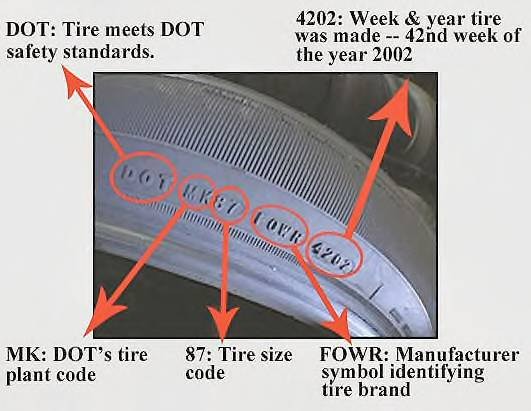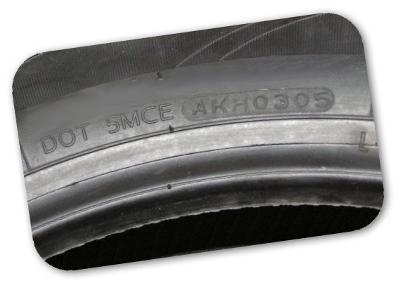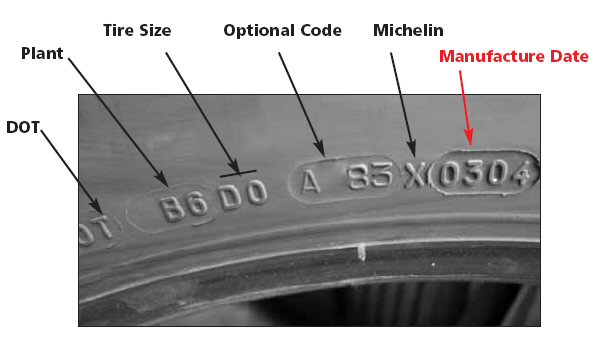
|
B arry's
Tire
Tech This is a series of articles on the technical aspects of tires, their care and usage. My primary purpose in these articles is to help people understand tires and thereby reduce the risks we all face every day. ..........and since tires is just about the only thing I know about.......... Please drop me a note if you have a topic you want to see: Barry@BarrysTireTech.com |
|
Update Dec, 2024: Tire Business, a newspaper of interest to tire dealers, published a list of the new 3 digit DOT plant codes. I've added it to the section on plant coding. Update Aug, 2022: I added some info about date codes BEFORE the current system. They are at the bottom of the page. Update June, 2022: I have made some more updates as indicated. Mostly links that no longer work. Update April 2015: NHTSA (National Highway and Traffic Safety Administration), the branch of the US government that regulates tires (and in this case, what is required to appear on the sidewall), has announced that they have run out of 2 digit plant codes (see below) and are making a change to a 3 digit plant code. I have updated the web page to reflect those changes. DOT Codes - also known as the Serial Number or the TIN (Tire Identification Number): |
| I get a lot of questions about how old a tire is. You can tell that - and a lot of other things - by reading (and decoding) the DOT code. |

|
First locate the letters "DOT" on the sidewall of the tire. Nearby will be the DOT code. DOT codes are 10 to 13 digits long. BTW the digits can be numbers or letters. Some Rules:
If the DOT code is less than 10 digits, you may be looking at a partial DOT code (without the date code). That is permitted on one side (the one not intended out). Look on the other side of the tire for the complete DOT code, including the date code. |
|
The first 2 or 3 digits are a code for the manufacturing plant. Prior to April of 2015, all plant codes were 2 digits, but after April of 2015, a third digit was permissible, and 3 digits are required by April of 2025. This means there will be a period of time where there will be both 2 digit and 3 digit plant codes. To make the transition easier, NHTSA has reserved a series of 3 digits codes starting with the number "1" (One) followed by the previous 2 digit codes. It is NOT required that everyone use this coding system, but I expect everyone to do so. So from April, 2015 to April, 2025, you will see both 2 digit and 3 digit plant codes - and the existing plant codes COULD use a "1" (One) in front. Nothing else in the coding system has changed.
|

|
|
Here's a web site that has an old version of the plant codes: From time to time, this gets updated, but don't depend on this being 100% right. December, 2024 Update: As stated below, the Harriger website no longer exists. But I found that Tire Business, a newspaper with tire related news, every December, publishes an updated list of DOT codes. The latest one was in the December 16, 2024 issue. I copied the list, not the entire issue. So if you look "5M" on this list, you should get Hankook in Kumsan Kun, Korea. Remember that the old DOT codes will, under the new system, start with the number 1, so look on this list for "15M". June 2022 Update: The Harriger website no longer exists. You can use the Wayback machine to get a copy of an archived version - OR - You can use the links below. Unfortunately the first one is on a law firm's website - a firm that sues tire manufacturers - so not only do I wonder why they are doing this, but the information might not be updated regularly, I also can't be sure it is 100% reliable. So be careful what you read there.
Wetherington Law Firm: Tire DOT Codes I also found a website that might be useful. It's a lookup, not a list: So if you look "5M" on the web sites linked above you should get Hankook in Kumsan Kun, Korea. End Updates |

|
The next 2 digits are a code for the tire size.
The Rubber Manufacturers Association, a US based industry group that represents folks who manufacture things out of rubber (and tires are a major player in this group), has published a suggested list of codes: Please note: This manual also gets updated from time to time, so don't assume this version is 100% accurate either. Also do not assume that everyone uses this coding system. I am aware that many European based tire manufacturers use a different system.
Also, there are different types of tires that require DOT coding. This lists only addresses Passenger, Truck, and Motorcycle tires (3 separate lists!) So looking at the DOT code to the left - the plant code is "VW" = Sumitomo in Osaka, Japan - and the size code is "VK" = 255/50R16 (or maybe something else!). |
|
The next 3 or 4 digits are a code for the type of tire.
The coding is optional, but since many tire manufacturers use the code to track returns, I don't know of anyone who doesn't use this coding. The photo to the right indicates that the "X" is for Michelin. While it may be true that all Michelin tires have an "X" in the type code, it is NOT true that Michelin is the only one who uses an "X" in the type code. Editorial Comment: One of the reasons I did this web site is because of things just like the photo to the right - Misinformation! So the plant code to the right is "B6" = Michelin in Spartanburg, SC, USA - and the size code is "D0" = 175/65R13 - and the exact tire is identified by "A83X" |

|

|
The last 3 or 4 digits are the date code. Starting in the year 2000, the date coding used was 4 digits. Before 1999 the format was 3 digits. 1999 and 2000 are transition years, so you will find both 3 and 4 digits used in tires produced in that time frame. So the DOT code to the right:
L9 = G78-14 (maybe!) ABC = the exact type of tire 032 = the 3rd week of 1992 (or 1982 or 1972!) but not 2002! |
|
Please Note: The date code only has to be on one side - and it is permissible for there to be a partial DOT code, so long as one side has the complete code. It is fairly common for everything except the date code to be on both sides, with the date code only being on one side. Starting in 2008, the full DOT code (with the date code) was supposed to be on the side intended out. On tires with a white sidewall or white letters, this would obviously be the "white side" that was intended out - and that's the side that the DOT code was supposed to be on. However, this created a problem for some manufacturers as this is typically the top half of the mold and to change the plate every week would require a man to stand in the hot bottom half of the mold while he made the change. Not only was this dangerous (Did I mention that it was hot?), but it also created problems with dirt and foreign objects in the bottom half of the mold. So they have petitioned NHTSA to change this requirement. I do not know what the outcome of this is going to be. Links to pages on vintage tire date coding (BEFORE the current system outlined above): Archived webpage: Goodyear Polyglas Tire Date Coding Date Code Mania - Goodyear Tire Decoding |
|
Barry's Tire Tech - Main Page |